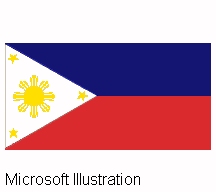
Leah W.
Current projects
I'm currently working on getting my poetry book published and I've been trying to get a record contract for the longest! I'm working on a way to get scholarships for my track and field and singing ability.

I chose the picture of the capitol building in Manila to show the different types of structures there are in the Philippines. I've chosen some clips and writings on the Philippines from Encarta 96.

Biography
I would like to talk about where my family is from. I have two sisters and a brother.
My sisters and I are all different as far as race is concerned. I'm Philippine and black, my sister is Philippine and white and my other sister is Philippine and Latino. All three of us were born in Spain
on a navel base but because we were born on American property and both our parents were American citizens we were as well.
Religion
Of the Philippine population, about 84 percent are Roman Catholics, about 4 percent are Muslims, and about 10 percent are Protestants or of other denominations, including the Philippine Independent Church, or Aglipayans, a schismatic group of Roman Catholics founded about 1902 by Gregorio Aglipay, a Filipino priest. [1]
Population
The term Filipino, which originally denoted a person of Spanish descent born in the Philippines and was comparable to the term Creole in the Spanish-American colonies, has been applied since the 19th century to the Christianized Malays who constitute the bulk of the Philippine population.
The aboriginal inhabitants of the archipelago were pygmy Negritos. During the prehistoric period Malayan peoples invaded the islands in successive waves beginning about 200 BC. The present Filipinos, principally descendants of the Malay invaders, are divided mainly according to language and religion. The most important numerically are the Visayans, livi primarily in the central portion of the archipelago, and the Tagalogs, in central Luzon. The Ilocanos (also spelled Ilokanos), the third most important group, live mainly in the Cagayan Valley on Luzon. People of Spanish and Chinese descent constitute the chief non-Malay groups. In the southern portion of the archipelago, particularly in western Mindanao, the Sulu Archipelago, and southern Palawan Island, are Moro Muslim groups. Mestizos, people of mixed Filipino and white or Chinese descent, form a small but economically and politically important minority.
Population Characteristics
The population of the Philippines (1990) was 60,703,206, giving an overall population density of about 204 persons per sq km (about 524 per sq mi). The distribution, however, is uneven; large areas are virtually uninhabited, while others have a relatively high population density. The nation was about 41 percent urban in the late 1980s. The population growth rate was about 2.7 percent per year. [2]
Principal Cities
Manila is the capital of the Philippines and the country's chief port and main commercial center. At the 1990 census, Manila proper had a population of 1,601,234, while the metropolitan area had 7,948,398 people. Other important cities include Quezon City (1,669,776), which is part of the Manila metropolitan area, and served as the country's capital from 1948 to 1976; Davao (843,607), a provincial capital and a seaport; Cebu (610,417), a seaport and the trade center for a farming and coal-mining region; and Zamboanga (442,000), also a seaport.
Interests / Hobbies
My interests are in poetry, singing, track, writing, and cooking.
I love to write poetry, short stories and novels. Writing is the only way I know how to express myself with words. All my words have expressions of love, hate, deep emotion and thought in them. I like to sing because I feel I have a nice voice and can really go somewhere with my pipes. My voice is very developed with control and discipline.
I can sing a note and in that note I can bring it into a run and hit a high note all in one breath. I like to run track because it keeps me in shape for my modeling job at Nordstrom's and I feel I'm pretty good but I'm no Flo-Joe! I love to cook because no matter what I invent it always tastes good.
[1]"Philippines, Republic of the," Microsoft® Encarta® 96 Encyclopedia. © 1993-1995 Microsoft Corporation. All rights reserved. © Funk & Wagnalls Corporation. All rights reserved.
[2]"Philippines, Republic of the," Microsoft® Encarta® 96 Encyclopedia. © 1993-1995 Microsoft Corporation. All rights reserved. © Funk & Wagnalls Corporation. All rights reserved.